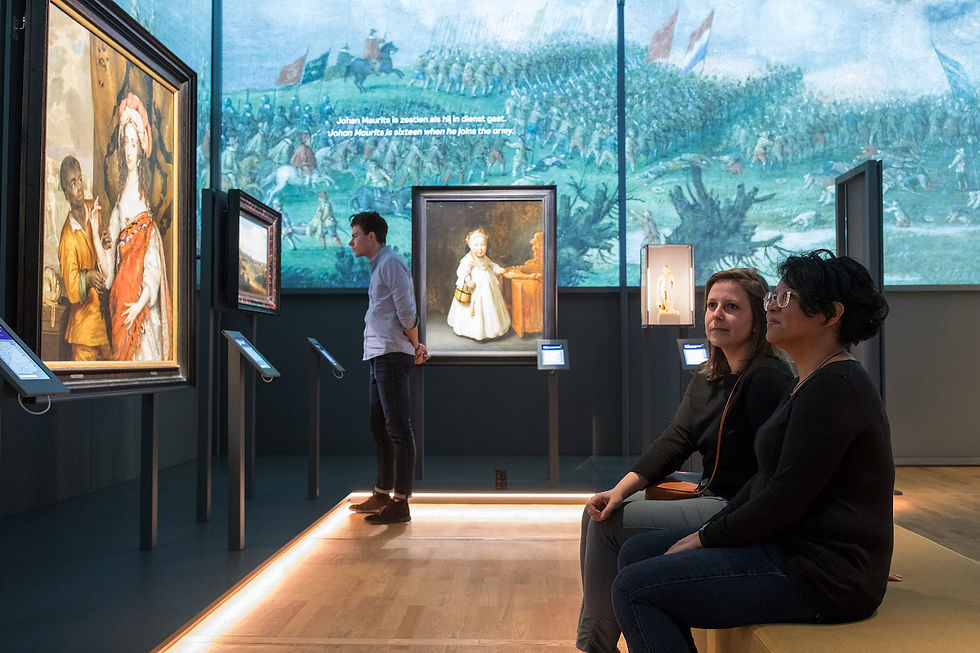When your museum's namesake was an enslaver
- Cait McQuade

- Apr 13, 2023
- 3 min read
Updated: Dec 17, 2024
Nestled in The Hague’s historic center sits the Mauritshuis, an art museum in a 17th-century mansion built by Johann Maurits. It holds some of the world’s most famous paintings: Girl with a Pearl Earring, The Goldfinch, The Anatomy Lesson.
Until 2018, you could also see an oversized bust of Maurits as soon as you entered the building. That year, the museum’s leadership decided to remove the sculpture.
The Dutch long regarded Maurits as a national hero, a patron of art and science. But more and more people began taking swings at his pedestal. While Governor of the Dutch colony in Brazil from 1636 to 1644, he not only enslaved Africans on his sugar plantation, he also facilitated his nation’s entry into the market for humans. On his return from Brazil he built his mansion, which people at the time nicknamed the Sugar House.
Removing the bust of Maurits sparked a Twitter storm. As far as I can tell, the Dutch haven’t done much public reflecting on their forbears’ enslavement of people. Rather than trying to sidestep the controversy, the Mauritshuis’s leaders stepped into it. In 2019 they opened an exhibit called Shifting Image: In Search of Johan Maurits, which I got to visit.

It occupied a single room. On entering, you ran right into the show’s instigator, Maurits’ massive white sculpture, backed by a wall lined with rows of tiny duplicate portraits. Word by word, a projector spelled out posts from the 2018 controversy on top of the little bearded heads.

To one side, filling a large alcove, a glittering white mound supported another sculpture, purpose-made for this exhibit: a four-foot-tall model of the Sugar House—the very building that contains the museum—made entirely out of sugar cubes.
A space bursting with color stood opposite these two, gleaming, white statements about Maurits’ significance as an historical actor and national symbol. Eleven objects, mostly paintings, glowed on elevated mounts against a black platform.
Behind and above the objects, filling three walls, a succession of projected images showed details of the things on display and other objects. These images related to Maurits, to the Dutch colony in Brazil, and to the Enlightenment society that profited from the colony. Fixed prominently beside each object: a luminous electronic tablet and no other text.
Into this relatively small space, the exhibit’s creators packed layers of interpretation. The most visually prominent was the juxtaposition of the displayed objects and projected images. Occasionally a phrase, in both Dutch and English, appeared in the projection, describing events or people in Maurits' life. This text was one of the few places where the museum’s institutional voice appeared.
The digital tablets in front of each displayed object held most of the exhibit’s interpretive text. You could scroll through screens and read different people’s reflections on each object. You could also choose to see a picture and a short description of the writers. They included Mauritshuis staff, and also biologists, historians, a politician, a social activist.
By presenting a variety of expert opinions, were the exhibit makers encouraging critical thinking or were they dodging responsibility for stating their own judgment? The two are not mutually exclusive. However, I believe the museum’s leaders had already made a firm statement by removing Maurits’ statue from the building’s entrance. Museums speak by positioning objects.
The exhibit—an extraordinary expression in an internationally acclaimed collection—acknowledged the public debate about the statue’s removal. It didn’t end the debate. It represented a mature response to the controversy (a public relations move, if you want to get cynical). No single action by a museum’s leaders could satisfy everyone in its community or fix social injustice. But this exhibit conveyed the Mauritshuis’ leaders sense of accountability to its community for its role in unjust social structures.
Finally, some thoughts on exhibit techniques:
By including art that supports your interpretation, you can engage people’s imaginations and emotions. Telling visitors that the museum’s building was called the Sugar House elicits quite a different reaction than the four-foot-tall sugary model.
With digital labels, you can stuff a lot of content into a small package and give visitors easy ways to navigate to content that interests them. On the downside, it was hard—in this exhibit—for more than one or two people at a time to access each label. And the jury’s still out on the best ways to manage digital content behind the scenes. Here are some case studies: The Getty National Museums of Scotland Auckland War Memorial Museum Australian National Maritime Museum
















Comments